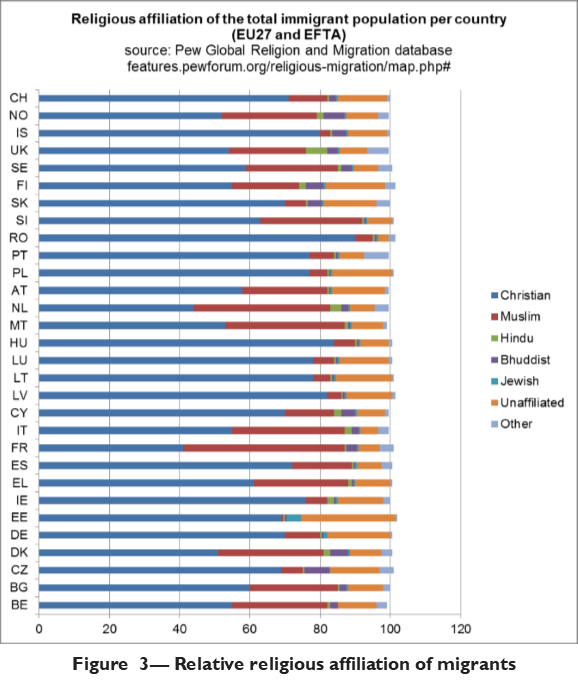Beyond the Stereotypes: The Realities of Migration in Europe today
There is no such person as a ‘typical’ migrant in Europe. The experiences of the trafficked girl from Eastern Europe, the African family living just down the road or an Asian working in a multinational company will be worlds apart. Even so, the stereotypes of non-Europeans flooding our borders, asylum seekers fleeing war and persecution, economic migrants taking national’s jobs or religious fanatics (read: Muslim extremists) are common and have become useful rallying points for political figures and the media who are pursuing their own agendas.
Recent reports from Eurostat and the Pew Research Centre give a helpful overview of the latest figures in migration, and go some way towards banishing these stereotypes.
The non-European migrant
There are just over 47 million foreign-born people living in EU27 countries, accounting for 9.4% of the population. Two-thirds of these are third-country nationals, but the numbers of people arriving from outside the EU are falling proportionately.
In 2008 EU-27 and EFTA countries received 1.8 million third-country nationals – less than 50% of the total population movement for that year. Arrivals in any particular country often reflect former colonial ties, such as Indians coming to the UK, or Indonesians to the Netherlands. Overall, the highest numbers of third-country nationals came from Turkey, Morocco, Albania and China.
In 2008 almost 2 million migrants arrived from other EU27/EFTA countries. In most cases, European citizens are able to travel freely within this area, although following the enlargement of the EU, temporary restrictions were placed on people from newer member states by some EU15 countries. The greatest numbers of these migrants came from Romania, followed by Albania, Portugal, the UK and Germany.
The asylum seeker
In 2011, there were 301,000 asylum applications registered in the EU27, up just over 40,000 from 2010. Around 10% were from repeat applicants and 9% of applications were from Afghanistan, 6% from Russia with 5% each from Pakistan and Iraq and Serbia. The same year, 75% of applications were rejected, although some of these will have been registered in previous years.
Many of these people, along with victims of trafficking or people smuggling, will have arrived in Europe without documentation or through ‘irregular means’. It is much harder to measure the extent of irregular migration – a recent EU research project called Clandestino estimated between 1.9 and 3.8 million irregular migrants across the EU, which amounts to 7-13% of all migrants.
The economic migrant
Many more people migrate for economic or family reasons. In 2008, almost 50% of male migrants gave employment as the reason, although 34% were looking for work rather than moving to a job they already had. A similar number (50%) of women migrated due to family reasons – although this figure is decreasing as more move for employment.
Economic migrants are also changing the age demographic in Europe In 2005, Eurostat forecast that from 2010, deaths would outnumber births and so any population growth between 2010 and 2025 would be from immigration to the EU from elsewhere. Given that the overall population of Europe is aging, the actual number of people of working age is already declining, leading to labour and skills shortages. So while some protest about jobs being filled by non-nationals, the reality is that they are needed.
The religious fanatic
56% of migrants identify themselves as Christian – more than twice the number who say they are Muslim (27%). If third-country nationals alone are counted, the numbers converge, with Christians making up 42% of migrants and Muslims comprising 39%. Unaffiliated migrants, who tend to come from China, Russia, Kazakhstan, UK or Germany count for 10% of all migrants and 8% of non-affiliated migrants
Figure 3 gives a country by country breakdown of the relative religious affiliation of migrants, France is the only country to receive more Muslim immigrants than Christian (46% and 41% respectively) with the Netherlands receiving 39% Muslims and 44% Christians.
If patterns of belief within Europe are reflected by European migrants, then many of the Christians are nominal. However the 13 million plus Christians from the global south are more likely to be practicing Christians, and as a result the immigrant churches are seen by some as the hope for the re-evangelisation of Europe.
Sources:
Pew Research Centre (2012) Faith on the move available from www.pewforum.org/faith-on-the-move.asp
Eurostat (2011) Migrants in Europe A statistical portrait of the first and second generation available from epp.eurostat.ec.europa.eu
Eurostat (2011) Statistics in focus 34/2011 available from epp.eurostat.ec.europa.eu
Clandestino (2009) Report from research.icmpd.org/1244.html for up to date information, go to clandestino.eliamep.gr/
Joanne Appleton


